SUBJECTS
GRADE
Show Results
'Catching' Tens and Ones
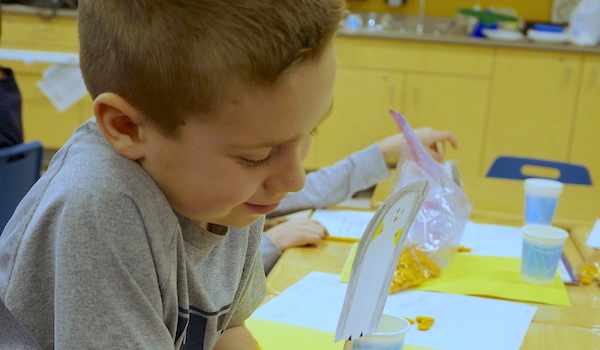
Lesson Summary
- Make, count, and write numbers in multiple ways.
- Create and use puppets to compose numbers and define math vocabulary.
Lesson Plan and Procedure
Lesson Key Facts
- Grade(s): K, 1, 2
- Subject(s): Drama, Math
- Duration of lesson: Three sessions, 30-45 minutes each
- Author(s): Lisa Garner and Emily Soderborg (adapted from Kathleen L. Stone)
Session One: Vocabulary Review
Use a hand puppet to review place-value vocabulary words.
Teacher: We have a new friend here with us today. This is (insert puppet’s name). Say hello! Yesterday we talked about the meaning of some math words. Let’s read these words with our new friend.
Show the word strips and read together “digit,” “tens,” “ones,” and “place value.”
Puppet: I wasn’t here yesterday! I don’t know what these words mean! Can any of you tell me what they mean? What is a digit? (Any of the symbols 0, 1, 2, 3, 4, 5, 6, 7, 8, or 9.) What are ones? (A single unit or object.) What are tens? (A group of something with 10 parts or units.) What is place value? (The value of a digit based on its place within a number.)
Note: With second grade you will need to have the vocabulary card for hundreds as well.
Puppet: That’s so helpful. I think I’m starting to understand. I’m going to sit and watch what you do today, so I understand even more.
Set the puppet down and read Penguin Place Value: A Math Adventure.
Showing Numbers Using a Tens and Ones Mat
Teacher: What patterns did we see in this book, as the penguins caught fish for their store? What other ways have we been showing tens and ones this week?
Teacher: Today we will show and talk about tens and ones in three different ways. (Show with goldfish, count out loud by tens and ones, and write in number sentences.)
Show students the counting mat, cups, and plastic sandwich bag filled with goldfish crackers.
Teacher: This mat will help us count the fish, like in the story. The white side represents the tray, holding the individual fish, or the ones. The cups represent the yellow boxes, holding a group of ten fish. Like in the book, once we have filled the tray that holds only nine fish, we need to move the nine to the cup that holds ten and add one more fish to make ten. This means the yellow side of the mat shows the tens place and holds groups of ten.
Refer back to the book to review how the fish are counted in the story.
Teacher: What is the greatest amount of fish that can be put on the tray at once? Where did the penguins put the fish from the tray once they had nine fish?
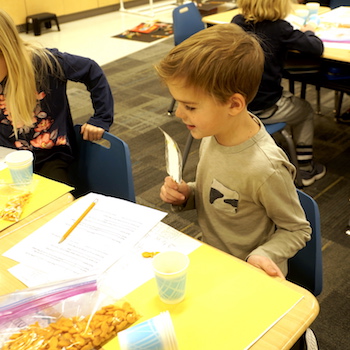
Teacher: When you return to your seat, you will get to eat five goldfish. After you've eaten, I will share a story problem about penguins and fish. You will need to show the number of fish caught by starting with the ones on the tray side of the mat, or the white side. Any questions?
Send them to their seats and let them eat their goldfish.
Teacher: Peter Penguin went out early to catch some fish. He caught one at a time until he had 12 fish in all. Show the number of fish Peter Penguin caught. Share with a table partner how many tens and ones there are in Peter’s igloo, waiting to be loaded on the truck for the store.
Watch and make sure the students count the number, starting with the ones, counting up to nine, pouring the nine fish in the cup, adding a tenth, and then starting over with the remaining two ones.
Making and counting representations of tens helps students develop conceptual understanding of place value. By counting groups of ones and then counting by tens, students learn the efficiency of using one ten to represent ten ones.
Teacher: I noticed that (insert student’s name) counted out her fish starting on the ones side until she got nine. Then she used the cup and added one more, so there were ten. Then she added two more fish on the ones side. She then counted the number out loud by starting with the cup of tens and added on the rest of the ones.
Call on a student to explain how he or she counted the goldfish and what the student told his or her partner. Have another student repeat what the student just shared with the class.
Have the students pour all the goldfish back into the bag to start over.
Create story problems with the following numbers and possible penguin names: 14, 21, 17, 20, 35, and finally, 40; Waddling Wanda, Paul Penguin, Diver Dave, and Sliding Sally.

Teacher: (After making 20) Are there 20 tens or 20 ones? (After making 40) Are there 40 tens or 40 ones?
Encourage students to support their reasoning. Also, have students repeat each other’s responses throughout to gain more active listening.
When making the final two numbers, after making the number on their mats, the students will write each number as tens and ones as well as in a number sentence on their small, personal whiteboards using the following format:
______3______tens and _______5________ones
_______30_______+_______5_________=________35_________
and
______4______tens and _______0________ones
_______40_______+_______0_________=________40_________
At the end, debrief as a class about the learning that has taken place.
Session Two: Creating Penguin Stick Puppets
Teacher: We had a puppet friend come visit us last time. Do any of you remember who that puppet is?
Bring the puppet out to use with students.
Teacher: I have a few questions to ask our friend today. After I ask my questions, I will let three students ask questions too, so pay attention and think of other things you would like to ask our friend.
Use the topics from the “Exploring Character” worksheet to ask the puppet questions.
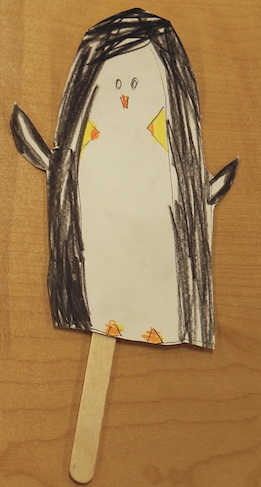
- The puppet’s full name
- The puppet’s nickname
- The puppet’s age
- What the puppet does for work
- What the puppet does for fun
- The puppet’s favorite food
- Something that scares the puppet
Model how to write down answers on the worksheet as an example for students to follow later in the session.
Teacher: Students, how would you describe the way our puppet friend talks? Does she have a high voice or a low voice? Does she talk really fast, at a medium speed, or really slow?
Call on three students to ask their questions.
Teacher: Today we are each going to create our own penguin puppets! After we have created the puppets, we will create characteristics for each of them.
Depending on the amount of time you want to spend, you can utilize different methods for creating penguins on cardstock.
- Option 1: Instructions for drawing penguins and blank cardstock to draw on (https://artprojectsforkids.org/easy-penguin-drawing/, https://www.youtube.com/watch?v=YK5qAF-eRG0, or https://www.drawingtutorials101.com/how-to-draw-a-penguin-for-kids-easy-printable).
- Option 2: Allow students to create a penguin by cutting out basic shapes from colored paper to layer, following similar steps shown for drawing.
- Option 3: Give students a penguin template to color and decorate with crayons, markers, or colored pencils.
Once the penguin is created, make it into a stick puppet by

attaching a popsicle stick to the back. The most permanent way to attach the stick is with glue. One easy way to use glue in the classroom is to create a glue station by pouring Elmer’s school glue on a sponge within a plastic container that has a lid. (This way the glue can be closed and won’t dry out.) Put the puppet right-side-down on the table. Press the popsicle stick on the sponge filled with glue. Lift the stick, then attach the stick to the penguin by placing the glued part of the stick on the back of puppet, which should be facing up. Press down for five seconds. Allow to dry completely before using the puppet.
When students have finished their penguins, have them use the “Exploring Character” worksheet to come up with details that help them create a unique character for their penguins.
As students finish, have them find other students who are also finished to introduce their puppets to.
Session Three: Showing and Talking About Tens and Ones
Using the same puppet as before, review math vocabulary.
Puppet: I’m so excited to see you again. When I was here before, we talked about the meaning of some math words, but I’ve already forgotten what they meant. Could you tell me again?
Teacher (to the puppet): Why don’t you help us read the words? It might help you remember. Everyone read together: “digit,” “tens,” “ones,” and “place value.”
Puppet: What is a digit? What are ones? What are tens? What is place value?
Call on students to give a definition for each vocabulary word.
Puppet: Now I remember! You previously made the numbers 14, 21, 17, 20, 35, and 40 using goldfish, cups, and place-value mats, but I don’t remember what it all meant. I’m a little forgetful. Can you help me remember?
Teacher: Class, how did we use our place-value mats as we counted and made numbers?
Help students review the way to use the mat.
Teacher: How many fish can we put on the tray at one time? (Nine.) Where do you put the fish from tray once you have ten fish? (In the box or cup on the yellow place-value side of the mat because it made a group of ten.)
Teacher: Today we will show tens and ones in four different ways, including writing the numbers. (Show with goldfish, count out loud by tens and ones, write in number sentences, and write in expanded notation.)
Teacher: You made your own penguin puppet, and now with the help of your penguin, “show” each number and tell your “penguin partner” the number of tens and ones your number has at your table. You will also write the number in different ways (show the sentence frame page).
Puppet: Let me show you how, using the following story problem: Waddling Wanda caught 17 fish.
Model, with the puppet helping, how to count out 17 fish using the place-value mat. Have the puppet count the number back, starting with the tens. Point to the cup and say, “ten.” Then point to each individual fish on the tray and say, “11 . . . 12 . . . 13 . . . 14 . . . 15 . . . 16 . . . 17.”
Display a blank sentence frame up on the board, so students can follow along. Have the puppet read the following sentence frame:
My number is _______17__________.
There are ___1_____ten(s) and ____7____ one(s) in 17.
That is ______10____________ (count how many total in the tens)
+ _______7______ (count how many total in the ones). (expanded notation)
That makes ________17____________ in all.
If I were to count how many ONES in all, there are ________17__________ ones.
Teacher: Here is your task today. When you return to your seat, I will share some more story problems about the penguins and fish.
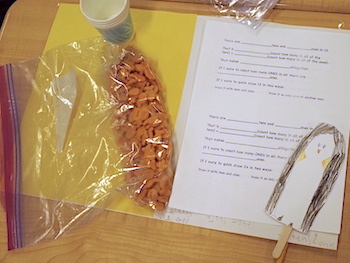
- You will show the number of fish caught, just like last time, starting on the white or tray side of the mat, then using the cups on the yellow side.
- Next, count the number by tens and ones, using your penguin, starting with the tens side first.
- Then, take turns counting out loud for your table partner, or “penguin partner.”
- Finally, you will fill in the sentence frame, as our puppet just showed you using the number 17.
Answer any questions students may have, and send them to their seats.
Note: At this point in the lesson, one suggestion is to arrange for students who demonstrated higher-level math skills with place value from session one to work in their own group with an aide or parent volunteer. If you do this, have them sit in a separate area. (See advanced student extension below.)
Teacher: Diver Dave went out early to catch some fish. He caught one at a time until he had 13 fish in all. Show the number of fish Diver Dave caught, using goldfish. Have your penguin puppet share how many tens and ones there are in Diver Dave’s fish igloo; then, take turns counting out loud with your table. After you have discussed the number with your partner, fill in the sentence frame.
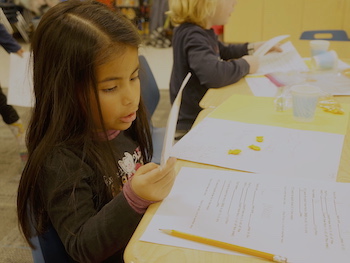
Repeat story problems with the following numbers and possible penguin names: 16, 24, 30, then 37 (fewer numbers today, since there is more talking and writing); Waddling Wanda, Paul Penguin, Peter Penguin, and Sliding Sally.
Help students to clarify the difference between tens and ones by asking the following:
Teacher: Are those 30 ones or 30 tens?
At the end, have the class debrief their learning.
Extension for Advanced Students or Second-Grade Students
Students will use the same place-value mat from session one but show numbers greater than 100. Help students discover that the brown construction paper and a large red SOLO cup can represent one hundred, or ten tens. When adding the tenth fish to the tenth cup, they can take the small Dixie cups and stack each one in a large red SOLO cup that represents a group of 100 or ten tens.
Repeat story problems with the following numbers and possible penguin names: 16, 114, 103, and 120 (fewer numbers today since there is more talking and writing); Waddling Wanda, Paul Penguin, Peter Penguin, and Sliding Sally.
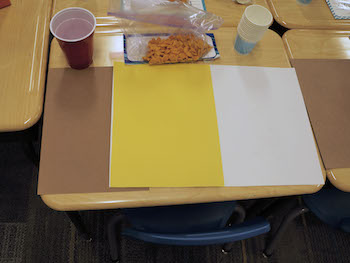
Teacher: Sliding Sally swam in the water, catching fish. She swam fast, catching one at a time until she had 114 fish in all. Show the number of fish Sliding Sally caught, using goldfish. With your puppet, share with your partner how many hundreds, tens, and ones there are in Sally’s igloo, waiting to be loaded on the truck for the store. After you have discussed the number with your partner, fill in the sentence frame.
Even though this group is showing larger numbers, it is beneficial to the students’ conceptual understanding of place value to make the number by beginning on the white side of the mat every time.
Quick-Draw Extension
Share with students an additional way to show a number by using various “quick draws.”
Teacher: If I were to quick-draw 13 in two ways, it could look like the following pictures.

Drawn as tens and ones (using straight lines to represent one ten and three small circles to represent ones)
OR
Drawn as only ones (13 circles would be drawn)
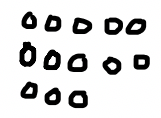
Learning Objectives
- Show and talk about tens and ones in multiple ways.
- Understand that the two digits of a two-digit number represent amounts of tens and ones.
- Use a puppet to observe, listen, and respond in character.
Utah State Board of Education Standards
This lesson can be used to meet standards in many grades and subject areas. We will highlight one grade’s standards to give an example of application.
Grade 1 Mathematics
- Standard 1.NBT.2: Understand that the two digits of a two-digit number represent amounts of tens and ones. Understand the following as special cases:
- 10 can be thought of as a bundle of ten ones, called a "ten."
- The numbers from 11 to 19 are composed of a ten and one, two, three, four, five, six, seven, eight, or nine ones.
- The numbers 10, 20, 30, 40, 50, 60, 70, 80, 90 refer to one, two, three, four, five, six, seven, eight, or nine tens (and 0 ones).
- Standard 1.MP.4: Model with mathematics. Identify the mathematical elements of a situation and create a mathematical model that shows the relationships among them. Identify important quantities in a contextual situation, use mathematical models to show the relationships of those quantities, analyze the relationships, and draw conclusions. Models may be verbal, contextual, visual, symbolic, or physical.
- Standard 1.MP.7: Look for and make use of structure. Recognize and apply the structures of mathematics such as patterns, place value, the properties of operations, or the flexibility of numbers. See complicated things as single objects or as being composed of several objects.
Grade 1 Drama
- Standard 1.T.P.3: Observe, listen, and respond in character to other actors.
- Standard 1.T.P.6: Use imagination to support artistic choices.
- Standard 1.T.P.9: Share dramatic play and guided drama experiences within the classroom or with invited guests.
Equipment and Materials Needed
- Stone, Kathleen L. Penguin Place Value: a Math Adventure. Place of publication: n.p., 2014.
- Vocabulary word cards: place value, digits, ones, tens, (hundreds for extension) (PDF of vocabulary cards for entire unit)
- Premade sorting mats of white construction paper on the right, yellow paper on the left
- Brown construction paper (optional for math extension when counting higher than 100)
- Goldfish crackers
- Small paper cups
- Ziploc sandwich bags
- Large red plastic cups (optional for math extension when counting higher than 100)
- Penguin Options:
- Option 1: Instructions for drawing penguins and blank cardstock to draw on (https://artprojectsforkids.org/easy-penguin-drawing/, https://www.youtube.com/watch?v=YK5qAF-eRG0, or https://www.drawingtutorials101.com/how-to-draw-a-penguin-for-kids-easy-printable)
- Option 2: Colored paper for students to cut to create penguins and cardstock to glue the colored paper to
- Option 3: Penguin template copied on cardstock (PDF)
- Colored pencils, crayons, markers, scissors
- Popsicle sticks (one per student)
- Glue to attach penguins to popsicle sticks
- “Exploring Character” worksheet (PDF)
- One copy of a sentence frame per student (PDF)
Additional Resources
This lesson is part of a unit using the arts to teach place value. The lessons can be found on the BYU ARTS Partnership website. The titles include the following:
- "Johnny Works with Place Value"
- “Penguin Place Value Emotions”
- “Place Value Pointillism”
- “Every Dancer Counts”
- "Waddling Ones and Tobogganing Tens”
- A video showing a similar place value activity
- Ideas for the “Exploring Character” worksheet were taken from a workshop, Puppetry and Drama Across the Curriculum! by Tamara Goldbogen and Katie Dawson
Image References
Images 1–9: Emily Soderborg.

www.education.byu.edu/arts/lessons
 Download
Download